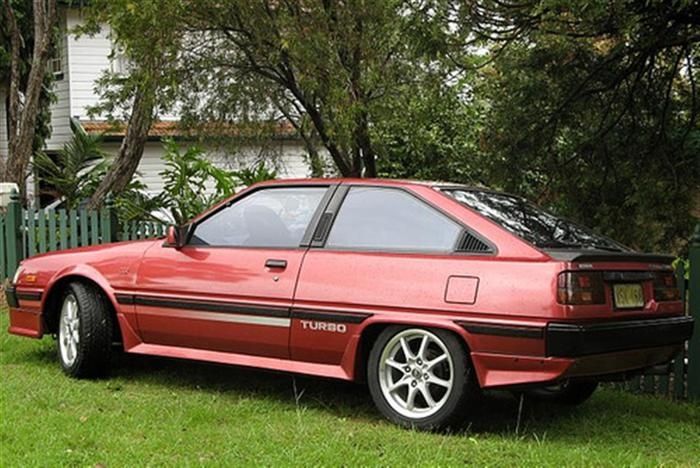The Mitsubishi Cordia came as an answer to the need for speedy sporty-elegant vehicles, alongside the likes of the Delorean from which it drew much inspiration. The Cordia built on what the Delorean couldn't deliver - reliability. Sporting a topnotch drivetrain at its time, Mitsubishi left nothing to chance in providing an automotive marvel that came to be the Cordia.
The Cordia is a three-door liftback coupe powered by a 4G6 series engine. Though its production run was short (8 years, from 1982 to 1990), the Cordia left a mark in the world.
1982-1985
The Cordia left history in various parts of the world, including the USA where it became the first car to be sold in the American market by Mitsubishi without the help of American motor company Chrysler. The Cordia debuted in 1982. Being a sports car, it cast a very similar design to the DeLorean but lacked the iconic seagull doors. It was a cross between the Galant and the Lancer and featured front-wheel drive as was standard in Mitsubishi Mirage. Apart from its larger size, the Cordia sported a MacPherson strut /beam axle suspension and upgraded front disc brakes. It came with an option between manual and automatic transmission modes and had the following engine choices:
- 1.4-litre 4G12T I4 petrol engine that produced 40kW of power
- 1.6-litre 4G32 I4 petrol engine that put out 40kW of power
- 1.6-litre 4G32T I4-T turbocharged petrol engine that produced 65kW peak power
In 1983, the Cordia received a significant facelift, which included a four-wheel-drive option in 1984. The 1984 model sported a 1.6-litre 4-cylinder I4 naturally-aspirated 4G12 engine that produced 210Nm and 110kW of power.
1985-1990
However, in 1985, Mitsubishi made the minor changes to the engine to make it able to run on unleaded petrol and introduced a 1.8-litre engine that came in both (70 kW) naturally aspirated and (101 kW) turbocharged options. The GSR came with power mirrors and a cassette player which were not standard by then.
- 1.8-litre 4-cylinder naturally aspirated petrol 3-speed automatic GSL engine that gave out 140Nm of torque and 70kW of power
- 1.8-litre 4-cylinder naturally aspirated petrol 5-speed manual GSL engine that produced 140Nm of torque and 70kW of power
- 1.8-litre 4-cylinder turbo powered petrol 5-speed manual GSR engine put out 210Nm of torque with 110kW of power
Australia got the AA series in the second phase of 1983 with a new design called the AB series released in 1984. Unfortunately, production for the Cordia stopped in 1988 for the Australian market. The 1988 release was the final model, and it featured three trims:
- 1.8-litre 4-cylinder naturally aspirated petrol 3-speed automatic GSL engine produced 130Nm of power with 62kW of power
- 1.8-litre 4-cylinder naturally aspirated petrol 5-speed manual gearbox GSL engine that had 130Nm of power and 62kW of power
- 1.8-litre 4-cylinder turbocharged petrol 5-speed manual transmission GSR engine that gave out 172Nm of torque and 90kW of power
In contrast, the previously released GSR models came with 13-inch alloy wheels while the unleaded models had 14-inch chrome alloy wheels. The 1800 Cordias had a pretty good reception in the Australian market, especially for the turbocharged versions. This power-rush, however, was not to last as the government laid strict emission regulations on Mitsubishi. In their response, both naturally-aspirated GSL and turbocharged GSR trims of the Cordia were stripped down in terms of power output with the following power trims
- 1.8-litre 4-cylinder naturally-aspirated petrol 3-speed automatic GSL engine that gave out 130Nm of torque and 62kW of power
- 1.8-litre 4-cylinder naturally-aspirated petrol 5-speed manual GSL engine that produced 130Nm of torque and 62kW of power
- 1.8-litre 4-cylinder turbo-powered petrol 5-speed manual GSR engine put out 130Nm of torque with 62kW of power
Despite Cordias downscale, the Australian police favoured the GSR and integrated it into their range of police pursuit cars.
After a while, Mitsubishi faced stiff competition from Toyota and Nissan with their Toyota AE86 and the Nissan Silvia S12 releases. Pushed to a tight spot, Mitsubishi upgraded the then old 1.6-litre engine model to a 1.8-litre engine. However, the new 1.8-litre version did not work well with Mitsubishi's DOHC engine.
At that time, Mitsubishi had put all efforts on reviving the Mitsubishi Tredia and were not in a financial position to work on upgrading their DOHC engine for the Cordia. With a looming economic crisis, Mitsubishi halted production of the Cordia in 1990 to put their affairs in order.
Despite its tragic end, the tale of the Mitsubishi Cordia shall be remembered as an automobile that represented the future at its time. Though Mitsubishi has not put in a word for it, there is hope that the Cordia will make it back to production lines once more.

